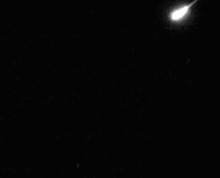Draconids

| Draconids (DRA) | |
|---|---|
| Pronunciation | /drəˈkoʊnɪdz/ |
| Parent body | 21P/Giacobini-Zinner[1] |
| Radiant | |
| Constellation | Draco (constellation) |
| Right ascension | 17.467h[1] |
| Declination | +54°[1] |
| Properties | |
| Occurs during | October 6 - October 10 |
| Date of peak | October 8 |
| Velocity | 20[2] km/s |
| Zenithal hourly rate | variable[1] |
The October Draconids, in the past also unofficially known as the Giacobinids, are a meteor shower whose parent body is the periodic comet 21P/Giacobini-Zinner. They are named after the constellation Draco, where they seemingly come from. Almost all meteors which fall towards Earth ablate long before reaching its surface. The Draconids are best viewed after sunset in an area with a clear dark sky.
The 1933[1][3][4] and 1946[1] Draconids had Zenithal Hourly Rates of thousands of meteors visible per hour, among the most impressive meteor storms of the 20th century. Rare outbursts in activity can occur when the Earth travels through a denser part of the cometary debris stream; for example, in 1998, rates suddenly spiked[5][6] and spiked again (less spectacularly) in 2005.[7] A Draconid meteor outburst occurred[8] as expected[9][10][11] on 2011 October 8, though a waxing gibbous Moon reduced the number of meteors observed visually. During the 2012 shower radar observations detected up to 1000 meteors per hour. The 2012 outburst may have been caused by the narrow trail of dust and debris left behind by the parent comet in 1959.[12]
References
- 1 2 3 4 5 6 Kronk, Gary W. "Draconids ("Giacobinids")". Meteor Showers Online. Archived from the original on 2018-06-27. Retrieved 11 October 2017.
- ↑ Żołądek, P.; et al. (October 2009), "The 2004 Perseid meteor shower – Polish Fireball Network double station preliminary results", Journal of the International Meteor Organization, 37 (5): 161–163, Bibcode:2009JIMO...37..161Z
- ↑ "The meteors from Giacobini's comet", Wylie, C. C., Popular Astronomy, Vol. 42, p.44, "The meteors from Giacobini's comet". Retrieved 2018-09-25.
- ↑ John McFarland and Mark Bailey (October 7, 2011). "Account of the 1933 Draconids meteor storm". International Meteor Organization (IMO). Retrieved 2011-10-08.
- ↑ "Giacobinids dazzle observers". October 14, 1998.
- ↑ Arlt, R. "Summary of 1998 Draconid Outburst Observations", WGN, Journal of the International Meteor Organization, Vol. 26, p. 256-259, 1998.
- ↑ Campbell-Brown, M.; Vaubaillon, J.; Brown, P.; Weryk, R. J.; Arlt, R. "The 2005 Draconid outburst", Astronomy and Astrophysics, Volume 451, pp.339-344, 2006.
- ↑ "Draconids show expected outburst". International Meteor Organization (IMO). Archived from the original on 2011-12-13. Retrieved 2011-12-06.
- ↑ Adrian West (October 3, 2011). "The Draconid Meteor Shower – A Storm is Coming!". Universe Today. Retrieved 2011-10-03.
Observers in the UK and Northern Europe are ideally placed to see the peak of the Draconids. Unfortunately the peak occurs in the day time for North America. There will also be a bright Moon which may drown out many but the brightest meteors, but if predictions are correct, you will still see many. You may see Draconid meteors on the 7th an the 9th also, so it is worth going out and checking the skies.
- ↑ "Draconids Meteor Shower on 8 October 2011". International Meteor Organization. Archived from the original on 25 September 2011.
- ↑ Beatty, Kelly. "A Deluge of Draconids?". Sky and Telescope. Highlights. Retrieved 31 December 2010.
- ↑ Geert Barentsen (2012-10-08). "Draconids show outburst (again!)". Retrieved 2012-10-08.
- Michael D. Reynolds. Falling Stars. Stackpole Books, 2001. p. 42.
- Jun-Ichi Watanabe and Mikiya Sato. "Activities of Parent Comets and Related Meteor Showers". Earth, Moon, and Planets, Vol 102, No 1-4 (June 2008). p111-116.
- Draconids 2011 ephemerides
External links
- Draconid Meteors Over Spain (Astronomy Picture of the Day 2011 October 19)
- The 2012 Draconid Storm Potentially Sampled By NASA ER-2 Aircraft (item 12)